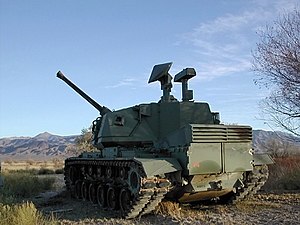M247 Sergeant York
| M247 Sergeant York | |
|---|---|

M247 Sergeant York in Dixie Valley, Nevada |
|
| General properties | |
| crew | 3 (driver, gunner, commander) |
| length | 7.674 m |
| width | 3.63 m |
| height | 3.42 m; with radar extended 4.611 m |
| Dimensions | 54.43 tons |
| Armor and armament | |
| Armor | Max. 120 mm |
| Main armament | 2 × 40 mm Bofors machine cannon |
| Secondary armament | 1 × 5.56mm machine gun and
2 × fog pots |
| agility | |
| drive | Teldyne Continental diesel engine AVDS-1790-2D 750 HP |
| suspension | Torsion bar |
| Top speed | 48 km / h (road) |
| Power / weight | 13.8 hp / t |
| Range | 500 km (road) |
The M247 Sergeant York DIVAD (Air Defense Division) was an American-made anti-aircraft tank (FlakPz) . The vehicle was supposed to replace the outdated M163 Vulcan anti-aircraft tank, but this did not succeed due to massive technical problems.
The vehicle was named after the American war hero of the First World War , Alvin C. York .
history
The M247 Sergeant York DIVAD arose from the request in the 1980s by the US Army for a fully autonomous , all-weather anti-aircraft tank that was to replace the outdated M163 Vulcan and MIM-72 Chaparral air defense systems . Both systems could not protect tank formations effectively against attacks by a Mil Mi-24 "Hind" , which is equipped with comparatively long-range 9K114 Schturm anti-tank missiles. New Soviet helicopters such as the Mil Mi-28 “Havoc” also required action. In addition, the US Army was in a process of transformation in the 1980s: new tanks such as the M1 Abrams or the M2 Bradley were introduced and the outdated flak tanks could not have followed them in the field.
Two drafts were submitted: General Dynamics wanted to equip the vehicle with an Oerlikon 35 mm twin cannon , which the German Gepard anti-aircraft gun tank was already armed with. The draft from Ford Aerospace and Communications Corporation , however, provided for armament with two 40 mm L / 70 Bofors automatic cannons . Both designs were based on the chassis of the M48 tank .
The Ford design finally won the bid and in 1983 the first M247 rolled off the production line. After 50 copies had been built, the project was discontinued in December 1986 due to insurmountable technical problems and financial bottlenecks.
technology
The fire control system and radar were a modification of the Westinghouse APG-66 system, which was already used in the F-16 Fighting Falcon fighter jet . In the test phase, various technical defects and faulty designs were discovered, which ultimately led to the end of the M247. In particular, the following proved to be problematic:
- The radar could not detect low-flying targets because of disturbing ground reflections from its own radar radiation (ground echo).
- The radar couldn't tell hovering helicopters from trees.
- When capturing higher-flying targets, the fire control system was irritated by radar beam reflections from the gun barrels.
- The turning of the tower was too slow to pursue fast-flying targets.
- The Electronic Counter Counter Measures system was too easy to override.
- The M48 chassis, which was 30 years old at the time, could not keep up with the more modern drives of the M1 Abrams or M2 Bradley.
- The Bofors cannons originally supplied by Sweden that were used had become brittle, rusty or bent due to incorrect storage, which resulted in a high number of jams.
